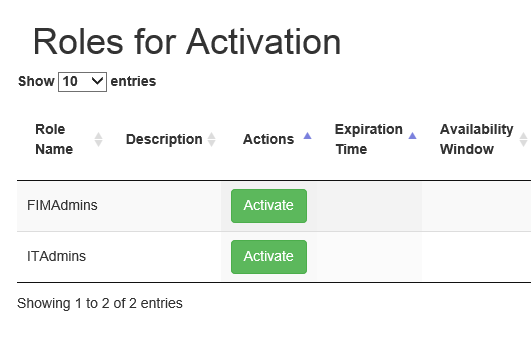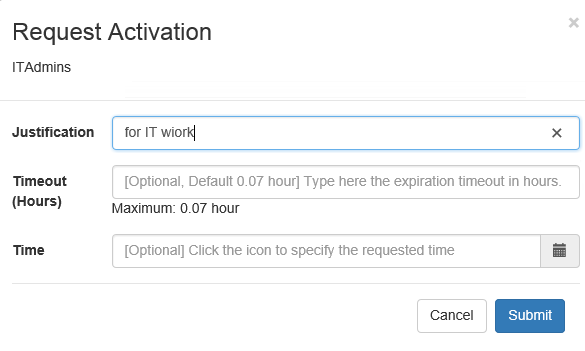

2019-02-07 18:11:00

If the screenshot above looks familiar to you, you need to pay attention. (Image source)
Microsoft's MIM is a widely used identity management platform for corporate environments. Many MIM tutorials, guides and books (including Microsoft's own site) [1][2][3] refer to Microsoft's sample PAM portal [4] to demonstrate how a request handling frontend could work. In this context, PAM stands for: "Privileged Access Management". While some of these sources make it clear that this is merely a demonstration, I can say without a doubt that there are companies that put this sample PAM portal to use in production environments. [5][6][7][8] Let me restate: there are enterprises putting the sample PAM Portal into production!
In short, the PAM portal allows an authenticated user to activate MIM "roles", which in turn will add groups to their account on-demand. By activating a role, MIM interacts with Active Directory and adds the groups configured for the role, to the end user's account. Unfortunately the sample PAM portal is not suited for production and I suspect that it has had little scrutiny with regards to the OWASP Top 10 vulnerabilities.
The cross-site scripting vulnerability that I ran into concerns the "Justification" field shown in the screenshot below. (Image source)

When activating a role, the end-user is presented with a popup asking for details of the request. The field labeled "justification" allows free entry of any text. It is not sanitized and the length appears to be limited to 400 characters. Through testing I have proven the ability to enter values such as:
<script>alert("Hello there, this is a popup.");</script>
<script>alert(document.cookie);</script>
These Javascript snippets are entered into the backend database without sanitation or conversion. The aforementioned 400 characters limit is easily enough for instructions to download and run shell code.
If we look at "Roles.js" on the Github page we see the following, where the form contents are loaded directly into a variable, without sanitation.
$("form#createRequestForm").submit(function(e){
var roleId = $("#roleIdInput").attr("value");
var justification = $("#justificationInput").val();
... ...
$.when(createPamRequest(justification,roleId,reqTTL,reqTime))
... ...
The "createPamRequest" function is defined in "pamRestApi.js", where yet again the input is not sanitized.
function createPamRequest(reqJustification, reqRoleId, reqTTL, reqTime) {
var requestJson = { Justification: reqJustification, RoleId: reqRoleId, RequestedTTL: reqTTL, RequestedTime : reqTime };
return $.ajax({
url: BuildPamRestApiUrl('pamrequests'),
type: 'POST',
data: requestJson,
xhrFields: {
withCredentials: true
}
})
}
The XSS comes into play when browsing to the "Requests" (History) or the "Approvals" tabs of the sample PAM portal. These pages respectively show the user's own history of (de)activation and other user's requests that are pending approval. After entering the code snippets above, visiting the "History" tab results in two popups: one with the short message and another one blank, as there are no cookie contents.
One viable attack vector would be:
The aforementioned sample PAM portal is a collection of Javascript bundles and functions, thrown together with some CSS and HTML. It has no database of its own, nor any data of its own. All of the contents are gathered from the MIM (Microsoft Identity Manager) database, through the MIM JSON REST API.
Based on the previously discussed vulnerability we can conclude that the MIM JSON REST API does not perform input validation or sanitation! At the very least not on the "Justification" field. The Javascript code I entered into the form was passed directly through the JSON API into the MIM database and was later pulled back from it (for the "Requests" and "Approvals" pages).
I have also verified this by delving directly into the database using SQL Management Studio. The relevant field in the database literally contains the user's input. There is no transcoding, no sanitation, etc.
I reported these issues to Microsoft through their responsible disclosure program in December, right before the holidays. After investigating the matter internally, they have provided a fix to the sample PAM Portal. The January 2019 revision of the code is no longer suceptible to an XSS attack.
Microsoft's resolution consists of hardening the coding of the PAM Portal itself: no data retrieve from the database will be interpreted as HTML. Instead it is hard-interpreted as plain text. Refer to the Github pull request chat for details.
They have NOT adjusted the MIM PAM REST API, which will continue to accept and store any user input offered. This means that accessing the API through Invoke-WebRequest is still susceptible to an XSS attack, because I-WR will happily run any Javascript code found. I showed this with examples earlier this week.
Anyone using the Microsoft MIM PAM Portal in their network should upgrade to the latest version of the project as soon as possible.
Also, if you are using the Powershell command Invoke-WebRequest to access the MIM PAM REST API, you should always adding the flag -UseBasicParsing.
kilala.nl tags: work, sysadmin,
View or add comments (curr. 0)
All content, with exception of "borrowed" blogpost images, or unless otherwise indicated, is copyright of Tess Sluijter. The character Kilala the cat-demon is copyright of Rumiko Takahashi and used here without permission.